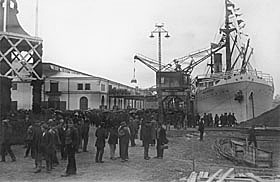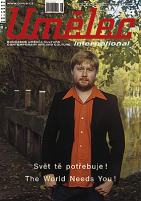| Zeitschrift Umělec 2001/4 >> Freeport | Übersicht aller Ausgaben | ||||||||||||
|
|||||||||||||
FreeportZeitschrift Umělec 2001/401.04.2001 Ulrika Stahre | rezension | en cs |
|||||||||||||
|
"Free Port: Janine Antoni, John Bock, Cosima von Bonin, Paul D. Miller, Magasin 3, Stockholm, 15 Sept. – 9 Dec.
2001 There are three towns called Freeport in my atlas, and all of them are visible remnants of a world order encompassing free-trade areas. But when Magasin 3 in Stockholm calls an exhibition Free Port, they are referring to the harbor, or free port, in the vicinity of the art gallery, and to free ports in general: places outside of the city and beyond the city’s control. The term was abolished in Sweden in 1996 — in an adjustment to European Union Law whereby “free port” was replaced by “free zone.” Sweden has no free zones; even though some geographical spaces are still called Freeport — in Stockholm, Gothenburg and Malmö — the activities that were associated with these places during the last century have all but disappeared. The idea is that the four artists who share the space at Magasin 3 relate to Stockholm’s free port as a historical place and environment. The port was opened in 1926 and the exhibition includes a few short films from the time, mainly showing the work being undertaken in a place that was considered modern, an example of progress. The world had opened up; contacts were manifested in imports of bananas, Madeira, car parts. Coffee was unloaded in heavy sacks. Stockholm became, at least according to the propaganda and in its own eyes, the center of the Baltic region and of all of Northern Europe. There is something fishy about the films: a double exoticisation of the dock workers and of the novelties that entered Stockholm. The harbor must be one of the most mythicised of places — seagulls, cranes silhouetted against the light, Marlon Brando, dusty overalls, beard-stubble — probably due primarily to the perfect collision there of freedom, estrangement, dreams, and movements. It’s capitalist port of trade and human connections. Across the sea, however, is something different. You never get as close to the other as in a harbor. Airports or stations are paler, more refined and artificial. The aim of Free Port is that performance art be combined with installation art. The idea is elegant: paralleling the way in which the harbor, on a symbolic level, combines the transient with the heavy and stationary. In a more critical tone one could also say that it also reflects the way in which the harbor has, in reality, been a playing field for the trade in goods and that labor has been translated into an economics of the visual. Our, the audience’s, thirst for unique experiences is fed with first showings involving performance elements, which prove to be the mainstay of the whole exhibition — processes are hard to exhibit and convey. Unfortunately the exhibition itself, with some excellent exceptions, has become boring. John Bock works with teaching and performance and scattered traces exist but they fail to communicate, while Cosima von Bonin’s work resembles stage design, events made permanent or a preparation for them. A boat covered with cloth, looking almost decorated, forms an emblematic point at the center of the exhibition. Paul D. Miller, DJ Spooky, samples both notes and pictures in a video installation that is shown in the same room as the documentaries. Here we meet the port as form, as buildings, movement, sketches, and color. Like a Russian futurist he lets loose a furious vibrating puzzle of primary forms, all projected on a mat of cut up record covers — circles with mutilated squares. His sound installation in another part of the hall is also a spatial commentary on the place in which we find ourselves, though closer both to dreams and to control. Janine Antoni’s Moor is composed of a long rope, one end of which has been slit and the other attached to a small boat. The rope is made of material donated by friends and relations, material that consists of everything from dental floss, plastic bags, and underpants, to T-shirts, telephone cords and fairy lights. The mooring to reality and to the social context is a clear idea in the piece, which also reflects the way global connections lack resistance — the dinghy floats far away from the cargo ships and all the work. Economies have become abstract, and the harbor is now a playing field far removed from banana stems and car tires. Translated by Abigail Booth "
01.04.2001
Empfohlene Artikel
|
|||||||||||||








Kommentar
Der Artikel ist bisher nicht kommentiert wordenNeuen Kommentar einfügen